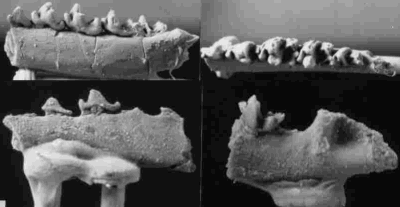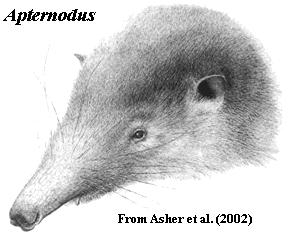 Nyctitheriidae: Amphidozotherium, Bayanulanius, Bumbanius, Ceutholestes, Darbonetus, Jarveia, Leptacodon, Limaconyssus, Nyctitherium, Oedolius, Paradoxonycteris, Plagioctenoides, Pontifactor, Remiculus, Saturninia, Voltaia
Nyctitheriidae: Amphidozotherium, Bayanulanius, Bumbanius, Ceutholestes, Darbonetus, Jarveia, Leptacodon, Limaconyssus, Nyctitherium, Oedolius, Paradoxonycteris, Plagioctenoides, Pontifactor, Remiculus, Saturninia, Voltaia| Insectivora | ||
| The Vertebrates | Soricoidea |
| Vertebrates Home | Vertebrate | Vertebrate |
|
Abbreviated Dendrogram
Eutheria
│
├─Insectivora
│ ├─Micropternodontidae
│ └─┬─Erinaceomorpha
│ └─Soricomorpha
│ ├─Tenrecoidea
│ └─┬─Solenodontidae
│ └─┬─Talpoidea
│ └─Soricoidea
│ ├─Nyctitheriidae
│ └─┬─Apternodontidae
│ └─┬─Oligoryctidae
│ └─┬─Parapternodontidae
│ └─Soricidae
│ ├─Crocidurinae
│ └─Soricinae
└─┬─Chrysochloroidea
└─Afrotheria
|
Contents
Index |
Soricoidea: classically this group joined the moles and shrews, rather than just the shrew stem group. Recent molecular phylogenies have revived the older concept of the Soricoidea, so that its definition is now in doubt.
Range: from the Early Paleocene
Phylogeny: Soricomorpha:::: Talpoidea + *: Nyctitheriidae + (Apternodontidae + (Oligoryctidae + (Parapternodontidae + Soricidae))).
Characters: maxillary root of zygoma much reduced [A+02$]; infraorbital canal short [A+02$]; foramen "superior to the jaw joint" near squamosal- parietal boundary, opening into a sinus canal "proximal to its anterior exit foramen into the orbitotemporal region" [A+02$] [1]; medial face of coronoid process deeply excavated, but without pocket [A+02$]; dentary condyle transversely expanded [C88]; deciduous teeth replaced very early [C88]; anterior lower premolars with single root [A+02$]; axis with prominent posteroventral keel [A+02$]; ulna articulates broadly with carpals [A+02$]; femur with obturator ridge (joining greater & lesser trochanters) absent [A+02$] femoral head continuous with greater trochanter [A+02$].
Notes: [1] This may be the canal visible in the dorsal Apternodus skull, below, just to the right of the middle line extending from the "lambdoid plate" label.
Links: Soricoidea Mikko's Phylogeny); Lund University, Doctoral Dissertation mtDNA: moles + shrew sister groups); Eurasian Insectivores and Tree Shrews - Status Survey and ... taxonomic history); 2000 abstracts mtDNA study with similar results); The Phylogenetic Position of the Talpidae Within Eutheria Based ... and yet another).
References: Asher et al. 2002) [A+02]; Carroll (1988) [C88]. ATW030728.
 Nyctitheriidae: Amphidozotherium, Bayanulanius, Bumbanius, Ceutholestes, Darbonetus, Jarveia, Leptacodon, Limaconyssus, Nyctitherium, Oedolius, Paradoxonycteris, Plagioctenoides, Pontifactor, Remiculus, Saturninia, Voltaia
Nyctitheriidae: Amphidozotherium, Bayanulanius, Bumbanius, Ceutholestes, Darbonetus, Jarveia, Leptacodon, Limaconyssus, Nyctitherium, Oedolius, Paradoxonycteris, Plagioctenoides, Pontifactor, Remiculus, Saturninia, Voltaia
Range: Early Paleocene to Early Oligocene [C88]; of North America & Europe.
Phylogeny: Soricoidea: (Apternodontidae + (Oligoryctidae + (Parapternodontidae + Soricidae))) + *.
Characters: upper molars dilambdodont [C88].
Note: there seems to be a great deal of very recent work on this family. Many reference citations on the web, but as yet very little information.
Image: dentition of Leptacodon (upper) and Nyctitherium lower) from the M.Sc. Thesis images page of Teresa Elise MacDonald.
Links: Nyctitheriidae Mikko's Phylogeny); mammals2 range); pal2 (more genera); Dr Jerry Hooker.
References: Carroll (1988) [C88]. ATW031118.
 Apternodontidae: Apternodus, ?Asiapternodus.
Apternodontidae: Apternodus, ?Asiapternodus.
Range: Middle Eocene Duchesnian) to Early Oligocene of North America [A+02] & ?Mongolia
Phylogeny: Soricoidea:: (Oligoryctidae + Parapternodontidae + Soricidae)) + *.
Characters: shrew to hedgehog sized [A+02]; cranial size small [A+02$]; rostrum shows muscle scars corresponding to well muscled proboscis (as in Solenodon) [A+02]; maxilla, zygomatic process reduced to minor projection above M1 [A+02]; sagittal crest present, forking anteriorly to flank posterior margins of nasal [A+02]; sagittal crest continuous with nuchal crest posteriorly [A+02]; lacrimal foramen enlarged, faces laterally [A+02]; anterior margin of infraorbital canal concave for muscles of anterior rostrum) [A+02]; zygomatic arch incomplete {A+02]; posterolateral portion of braincase expanded as box-like lambdoid plates comprised of squamosal, petromastoid & occipitals, all exposed laterally [A+02$]; squamosal exposure on ventrolateral margin of skull short [A+02$]; postglenoid process absent [A+02]; ossified auditory bulla absent [A+02]; petrosal does not form or contribute to bulla [A+02$]; petromastoid, external aspect, anterior to nuchal crest and broadest in lateral view [A+02$]; mastoid tubercle present as ventrally projecting process posterior to external auditory meatus and anterior to occipital condyles and paroccipital process [A+02$]; epitympanic recess extends anteriorly, bounded by entoglenoid process [A+02]; anterior wall of tympanic cavity concave [A+02]; piriform fenestra usually present [A+02$]; enlarged entoglenoid process medial to postglenoid foramen & anterior to middle ear (supports dentary condyle posteriorly) [A+02]; entoglenoid process concave posteriorly, forming recess in anterior wall of tympanic cavity [A+02$]; anterior carotid does not enter cranial cavity via piriform fenestra [A+02$]; ethmoid foramen and sinus open into orbitotemporal region through roof of sphenorbital fissure [A+02$]; dentary, coronoid process hides part of m3 in lateral view [A+02$]; dental formula 2/3, 1/1, 3/3, 3/3 [A+02]; teeth may have been pigmented (but could be artifact) [A+02]; both I1/i1 enlarged & procumbent [A+02]; 2 incisors on premaxilla [A+02$]; P4/p4 molariform [A+02]; molars zalambdodont [A+02]; metacones absent [A+02]; talonids reduced to single cusp without basin [A+02].
Links: paleng2_3cont abstract on new Mongolian form); Институт проблем экологии и эволюции имени А. Н. Северцова Russian abstract of related work).
References: Asher et al. 2002) [A+02]. ATW030725.
| |
|
Oligoryctidae: Oligoryctes Hough 1956.
Range: Early Eocene Bridgerian) to Early Oligocene Orellan) of North America & possibly Asia (China?) [A+02].
Phylogeny: Soricoidea::: (Parapternodontidae + Soricidae) + *.
Characters: shrew-sized [A+02]; lacks sagittal crest; lacrimal foramen large & laterally oriented [A+02]; zygomatic arch essentially absent [A+02]; lambdoid plates absent [A+02]; squamosal & petromastoid somewhat expanded, but laterally rounded [A+02]; squamosal extends posteriorly along ventrolateral margin of braincase lateral to large piriform fenestra (similar to Apternodus) [A+02]; large entoglenoid process as in Apternodontidae [A+02]; foramen ovale extremely large [A+02$]; alisphenoid canal absent [A+02] [1]; no ossified bulla [A+02]; anterior exit of sinus canal & ethmoid foramen located well anterior to sphenorbital fissure [A+02]; coronoid process laterally convex [A+02$]; medial face of coronoid process deep or pocketed [A+02]; I1 not enlarged [A+02$]; last two lower incisors (i3-4?) with 3 distinct cusps [A+02$]; P3 buccal margin longer than in P4 [A+02$]; molars zalambdodont [A+02]; last two lower incisors are tricuspid [A+02]; metacones absent [A+02]; upper molars with distinct protocones & mesial cingula [A+02]; talonid basins reduced [A+02]; paraconids project upwards (not inclined); m3 talonid cusp taller than m3 paraconid [A+02$]; m3 mesiodistally longer than other molars [A+02$].
Notes: [1] for purposes of comparison, the opening to the alisphenoid canal in the Apternodus basicranium above is the rather large unlabelled foramen in the upper left-hand corner of the figure. The foramen ovale is just below and to the right of this foramen, immediately to the left of the entoglenoid process.
References: Asher et al. 2002) [A+02]. ATW030726.
Parapternodontidae: Koniaryctes Robinson & Kron, 1998; Parapternodus Bown & Schankler, 1982.
Range: Early Eocene Wasatchian) of North America.
Phylogeny: Soricoidea:::: Soricidae + *.
Characters: shrew-sized [A+02]; first incisor very long [A+02]; molars zalambdodont [A+02]; lower molars with reduced, unbasined talonid [A+02]; buccal cingulids weak or absent [A+02$]; m3 mesiodistally shorter than m1 or m2 [A+02]; m3 distal cusp absent [A+02];
Note: known only from fragments of teeth & jaws.
Links: Volume 32 No. 2 short abstract on Koniaryctes).
References: Asher et al. 2002) [A+02]. ATW030726.
checked ATW040725